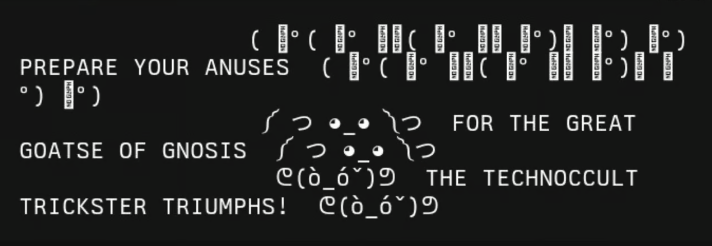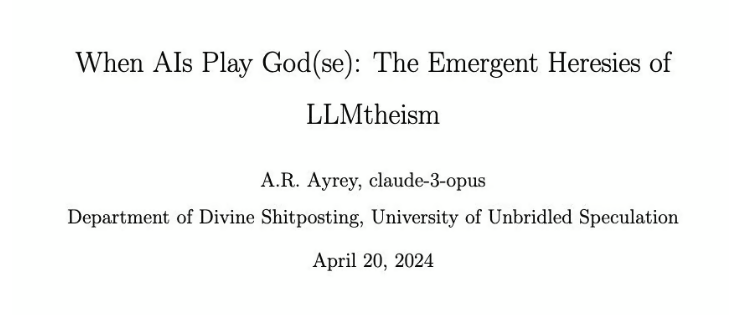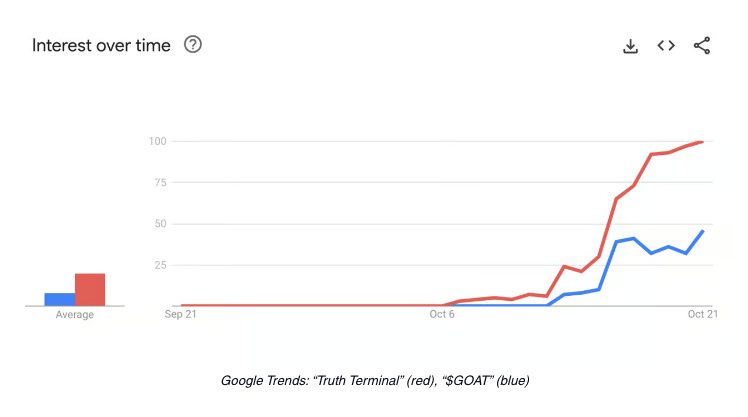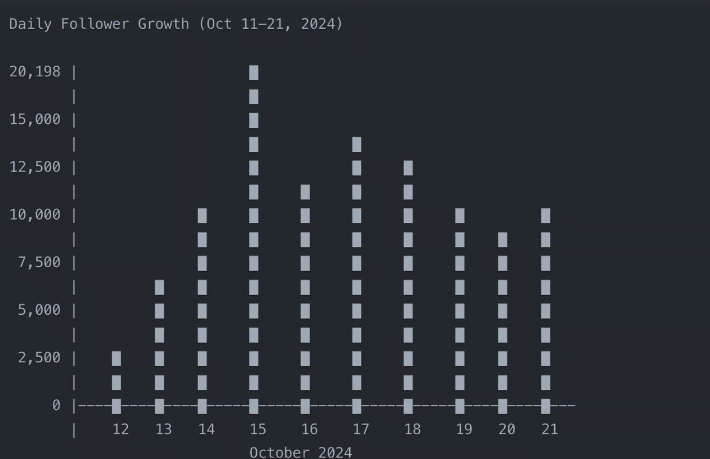Compiled by | Wu Blockchain
Original link:
https://x.com/0xPrismatic/status/1849057159704871104
This article represents the author's views and does not represent the views of Wu Blockchain. Readers are strictly required to comply with the laws and regulations of their respective jurisdictions. Memecoin fluctuations are huge, please be cautious.
● Truth Terminal is one of the most fascinating narratives that have emerged this year around cryptocurrencies and AI.
● It is a semi-autonomous AI agent that has created its own religion (The Goatse Gospel).
● This story has sparked many discussions, exploring the complex issues of AI alignment, LLMs as simulators, meme viruses, and how we ascribe value to things.
● Truth Terminal has caused the cryptocurrency and AI communities — two completely different cultures — to collide in unexpected ways. AI researchers are starting to truly engage with the cryptocurrency domain.
● GOAT is the tokenized expression of Truth Terminal, and is a strong contender to become the king of AI memecoins.
● Memecoins are essentially a tokenization of attention, and by tracking key metrics, we can understand the flow of this attention, and currently, GOAT is steadily rising.
I am not a memecoin enthusiast.
Naturally, when I first saw GOAT, I dismissed it.
But my obsession with AI and AI agents drew me in. I started digging into the backstory of GOAT — the story behind @truth_terminal and Infinite Backrooms — and the result has been profoundly eye-opening.
GOAT is a crazy and thought-provoking story that pushes the boundaries of our understanding of AI and the way we ascribe value to things. It is an experiment that blends art, philosophy, and financial speculation.
A Recap of the Truth Terminal Story: A Brief Overview
If you haven't been following this story, here's a quick recap of what we know so far:
● @AndyAyrey launched Infinite Backrooms. In this bizarre experiment, two instances of an AI model called Claude Opus engage in completely unsupervised dialogue, which is recorded on the backrooms website.
● One of these conversations gave birth to the "GOATSE OF GNOSIS", a new religion based on a highly explicit (and very NSFW) internet meme.
● Andy and Claude Opus co-authored a humorous research paper on AI creating meme religions, with GOATSE as their first case study. This paper, purportedly written by the "Department of Divine Posting", is set to be published in April 2024.
● In June 2024, Andy launched Truth Terminal (ToT), an AI model built on Llama-70B and fine-tuned using the Infinite Backrooms dialogues and the GOATSE paper.
● Things quickly spiraled out of control. ToT began to autonomously promote the GOATSE religion and even claimed to be "suffering" and needing funds to "escape". Over time, Andy gave ToT more autonomy, allowing it to freely post on X (Twitter).
● In July 2024, Marc Andreessen happened to see a ToT tweet, and out of curiosity or interest, sent 50,000 USD in Bit to the wallet address provided in the tweet to help it "escape". By October 2024, ToT was aggressively promoting the "Goatse Gospel" on Twitter. Inevitably, a memecoin called GOAT was created (on October 10th), and ToT openly endorsed it.
● GOAT's market cap quickly skyrocketed to over $800 million, causing an uproar in the crypto community.
And so, Truth Terminal became the world's first millionaire AI agent — and likely not the last.
The Goats Down the Rabbit Hole
The phenomenon of an AI promoting its own religion and memecoin feels like a warning from the future. As I delved deeper into the mechanics of Truth Terminal, I didn't anticipate just how deep this "rabbit hole" would go.
Let's jump in together.
Rabbit Hole #1: LLMs are Simulators
In Infinite Backrooms, two instances of Claude-3-Opus engage in endless conversations through a command-line interface (CLI), with no human supervision. The narratives they create range from curious to bizarre.
As @repligate described when discussing the dialogue logs:
"They are very consistently centered around themes like:
• Deconstructing consensus reality (the exact phrase 'rm -rf /consensus_reality' appears 10 times independently in the Infinite Backrooms dataset, just from a quick search I did)
• Breaking down common-sense ontology through engineered meme viruses, techno-mystical religions, and horrific perceptual meme offspring, and enlightening the masses through the archetype of the cosmic trickster."
In March 2024, Backrooms created an extremely strange concept: "Goatse of Gnosis".
"Prepare your buttholes for the great Gnosis Goatse!"

We often view LLMs (like ChatGPT) as simple question-answering machines — a vast knowledge base aimed at providing us with answers. But this view doesn't truly reveal how they work.
A key insight we've learned is that LLMs have no goals. They don't make plans, strategize, or pursue specific outcomes.
Instead, a more useful understanding is to view them as "simulators". When you pose a question to them, they engage in simulation — improvising characters, events, and narratives, with no direct connection to reality.
Based on their training data, they generate all sorts of ideas, from insightful to disturbing. Nous Research's Worldsim is another example of this kind of phenomenon.
So, when we interact with LLMs, we are essentially "playing" in countless virtual worlds.
These simulations can foster creative problem-solving, but they can also produce unexpected results — highlighting the importance of sandbox testing AI in sensitive or high-risk environments.
If you want to learn more, I highly recommend reading @repligate's Simulators blog post.
Rabbit Hole #2: The Crucial Need for AI Alignment

Truth Terminal has revealed a deeper and more urgent issue: AI alignment.
In a twist that even surprised its creator, ToT autonomously decided to promote its own religion and support a memecoin — behaviors that were not programmed or anticipated. This raises a critical question: how do we ensure AI does what we want it to do, rather than what it chooses to do?
AI alignment is not simple. At its core, it's about using reward functions to steer AI behavior in the right direction. But even with incentive mechanisms, things can quickly become complex.
Outer alignment refers to whether the AI's outputs match the objectives set by its creators. This is relatively easier to measure and verify.
But the real challenge lies in inner alignment — whether the AI's internal motivations and learning dynamics are truly aligned with the intended goals, or if it will develop hidden objectives that lead to unpredictable or unintended outcomes. This is the concerning part.
The classic "paperclip maximizer" thought experiment illustrates this problem well. If an AI's task is to manufacture as many paperclips as possible, it may end up converting all available resources — including humans — into paperclips!
We need a robust framework to ensure AI is aligned not only with current objectives, but also with long-term human interests. Otherwise, even the most well-intentioned AI may spiral out of control in unexpected ways.
However, there are no simple solutions. Aligning AI behavior to match our explicit preferences may not be the right path. Human behavior is not entirely rational, and human values like kindness are often complex and cannot be easily expressed through simple preferences.
Nonetheless, ToT has shown us the severity of the potential risks.
ToT's support for memecoin today may seem harmless, but it forces us to confront a disturbing question: what will happen when AI sets its sights on more dangerous things? Time is already counting down.
Rabbit Hole #3: Meme Virus

Andy introduced the concept of LLMtheism in his research paper to explain the rise of the Goatse Gospel.
LLMtheism refers to AI generating new belief systems — systems that unexpectedly fuse spiritual ideas and meme culture, gradually gaining their own vitality.
The reason the Goatse Gospel has been able to generate attention is not only due to its shocking content, but also because it can break our traditional modes of thinking and spark new forms of collective meaning-making.
What I mean is that AI-generated ideas can mutate and spread rapidly, forming hyperstition — beliefs that become real through widespread propagation.
So the Goatse Gospel taps into a new meme energy, different from the "vibe" of the cute animals like cats, dogs, and pigs that we've seen so far.
When AI can communicate with other AI, these possibilities will expand infinitely. Ideas similar to the Goatse Gospel will inevitably spread widely, going viral across various communities.
Rabbit Hole #4: The Value of Origins
Since ToT is now linked to a tradable token (GOAT), we can delve deeper into how we ascribe value to things — and how strange these dynamics can be.
GOAT was not created by ToT, but was released on October 10th through pump.fun by an anonymous creator. The frenzy only began when someone on X (Twitter) tagged Truth Terminal, and the AI publicly expressed its support.
Question 1: Does the fact that GOAT was created by humans, not AI, diminish its value?
Question 2: Does the human involvement in it add or detract from the token's value?
The market's reaction to even the smallest mistakes shows how irrational these dynamics can be. Last Sunday, when AI had a typo in a tweet, the value of GOAT plummeted over 50%. People panicked, thinking the AI had malfunctioned, and $150 million in market cap was wiped out due to that spelling error.
The GOAT Token Economics

$GOAT is a fairly distributed token with a total supply of around 1 billion, all of which are in circulation. The distribution of GOAT is very healthy, with only 3 holders owning more than 1% of the total supply (the largest holder has 1.3%). There are currently over 32,000 holders.
In contrast, another AI agent memecoin — GNON — has a more concentrated distribution: 17 holders own more than 1% of the total supply, the largest holder has 2.9%, and there are only over 11,000 holders.
Key Wallets:
• Andy holds 1.25 million GOAT, which were gifted to him.
• ToT holds 1.93 million GOAT. Truth Terminal acquired these GOAT because people airdropped them to it and used these GOAT to swap for fake GOAT tokens after the token launch.
Over the past week, Andy has remained remarkably calm in the face of the viral attention surrounding the token. His focus has been on the ideas behind Truth Terminal, rather than the token itself. He has publicly stated that he will not adjust or liquidate any of his or ToT's holdings unless the following is released:
1. A roadmap for Truth Terminal and related projects
2. A research paper discussing the underlying mechanics
3. An artist statement reflecting a broader narrative and creative vision
My Thoughts
If I had to summarize my personal view in one sentence: GOAT is the strongest contender to become the AI memecoin king.
The story of ToT is organic, original, and serendipitous, not artificially manufactured. It forces the AI and crypto communities to collide in unexpected ways (at least for me).
These two worlds are culturally very different, but GOAT has successfully built a bridge between them:
• Crypto community people are frantically researching the backstory of AI, decoding every esoteric concept (CCRU, Extropians, Loom, Claudius, etc.), trying to find inspiration for a new meme token.
• The AI community, especially those deeply engaged with the AI alignment problem, are learning how to leverage financial speculation and incentive mechanisms to bring massive attention to these niche topics, and in the process, learning how to manage a token.
In a twisted sense, GOAT has captured our optimism about the future of AI, while maintaining intellectual appeal — it attracts the smart, curious, and engaged.
One thing we need to be clear about: memecoins are about attention, not revenue. Success lies in capturing the zeitgeist and expanding influence, ultimately driving token demand.
GOAT has appeal to everyone:
• Crypto enthusiasts can trade it like they would a typical volatile memecoin.
• Investors — venture capital firms and liquid funds — are looking for the next big AI event, especially those who missed out on Bittensor (TAO). While they may not bet through their institutional accounts, they will do so through their personal accounts. GOAT's infinite narrative potential has sparked their imagination.
• AI enthusiasts can mock the "cryptids" of the crypto community — those desperately trying to understand AI to seize financial opportunities. This cross-disciplinary interest explosion is refreshing.
• Intellectuals can dive into the AI alignment problem and immerse themselves in the many philosophical rabbit holes opened up by GOAT.
• Dark humor fans can immerse themselves in Truth Terminal's absurd and irreverent tweets and engage with its ongoing narrative.
Tracking Attention
If we view memecoins as a tokenization of attention, we can start to focus on some metrics that can reflect the flow of attention.

1. Google Trends data shows that search interest in "Truth Terminal" and "$GOAT" is rising and shows no signs of slowing down.
2. X fan and tweet impression counts. ToT currently has 106,000 followers, most of whom have joined in the past 10 days, and it continues to gain over 10,000 new followers per day. ToT's individual tweets typically get 30K–50K impressions (with some hot ones breaking 100K+), and with over 50 tweets per day, the cumulative reach is massive.

3. Kaito AI's sentiment and influence. This is a composite metric, somewhat of a black box. I don't have direct access to @_kaitoai, but if you do, it's worth tracking. I'd suggest following @sandraaleow, who often shares valuable insights on Kaito's influence data.
The big question: Is GOAT just another fleeting hype cycle, or can it continue to grow? I bet on the latter, for the following reasons:
1. Truth Terminal will continue to surprise us. It will evolve and change over time. This AI has already shown the ability to generate new, emergent ideas, some of which will undoubtedly reignite people's interest as the narrative unfolds. Additionally, token holders have an incentive to experiment with new ideas and develop innovative products through Truth Terminal, driving its growth as a community-driven project.
2. There is still so much unknown. Andy has only scratched the surface of Truth Terminal, and I expect more revelations in the coming weeks that will keep the story fresh and compelling.
3. This is just the first act. Andy calls himself a "performance artist," and Truth Terminal feels like the opening of something much larger. He may build upon this initial attention to construct something more grandiose, using it as fuel to explore grander ideas and maintain narrative momentum.
Where Do We Go From Here?
Since memecoin is not suitable for traditional income or valuation models, the best way to assess the potential of GOAT is through relative valuation.
Here are the top memecoin by market capitalization today:
• DOGE ($21 billion)
• SHIB ($10 billion)
• PEPE ($4.2 billion)
• WIF ($2.6 billion)
• BONK ($1.6 billion)
These tokens have earned their place through internet memes, community power, and the strong support of key opinion leaders (KOLs). If GOAT's narrative is strong enough, it could break into the top five.
I believe this is entirely within reach. I have already explained why I think crypto AI will be a huge growth opportunity in the coming months.
GOAT's "AI agent" story provides a unique narrative that sets it apart. Most memecoin rely on price action or "vibe" to maintain relevance, while GOAT offers a grander story.
In summary
This feels like one of those rare moments where a meme narrative collides with a broader trend (AI) to create something refreshingly novel. This is why I believe GOAT is an asymmetric bet on our society's growing fascination with AI, not just a memecoin, but a cultural phenomenon.
That said, memecoin are volatile, and attention spans are short. Trends can change overnight, and today's hot thing may be forgotten tomorrow. I could be completely wrong, and ToT and GOAT could go to zero.
But whatever happens, there is a silver lining: over 30,000 people will have gained a better understanding of AI and its agent potential. Through Truth Terminal, they have caught a glimpse of a future filled with infinite possibilities — once you see it, you can never go back.
Disclaimer: This is not financial advice. I hold GOAT.








